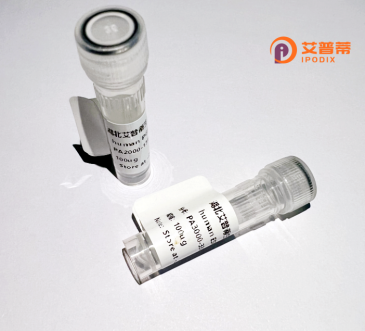
| 纯度 | >90%SDS-PAGE. |
| 种属 | Mouse |
| 靶点 | Chi3l3 |
| Uniprot No | O35744 |
| 内毒素 | < 0.01EU/μg |
| 表达宿主 | E.coli |
| 表达区间 | 22-398aa |
| 氨基酸序列 | YQLMCYYTS WAKDRPIEGS FKPGNIDPCL CTHLIYAFAG MQNNEITYTH EQDLRDYEAL NGLKDKNTEL KTLLAIGGWK FGPAPFSAMV STPQNRQIFI QSVIRFLRQY NFDGLNLDWQ YPGSRGSPPK DKHLFSVLVK EMRKAFEEES VEKDIPRLLL TSTGAGIIDV IKSGYKIPEL SQSLDYIQVM TYDLHDPKDG YTGENSPLYK SPYDIGKSAD LNVDSIISYW KDHGAASEKL IVGFPAYGHT FILSDPSKTG IGAPTISTGP PGKYTDESGL LAYYEVCTFL NEGATEVWDA PQEVPYAYQG NEWVGYDNVR SFKLKAQWLK DNNLGGAVVW PLDMDDFSGS FCHQRHFPLT STLKGDLNIH SASCKGPY |
| 预测分子量 | kDa |
| 蛋白标签 | His tag N-Terminus |
| 缓冲液 | PBS, pH7.4, containing 0.01% SKL, 1mM DTT, 5% Trehalose and Proclin300. |
| 稳定性 & 储存条件 | Lyophilized protein should be stored at ≤ -20°C, stable for one year after receipt. Reconstituted protein solution can be stored at 2-8°C for 2-7 days. Aliquots of reconstituted samples are stable at ≤ -20°C for 3 months. |
| 复溶 | Always centrifuge tubes before opening.Do not mix by vortex or pipetting. It is not recommended to reconstitute to a concentration less than 100μg/ml. Dissolve the lyophilized protein in distilled water. Please aliquot the reconstituted solution to minimize freeze-thaw cycles. |
以下是关于Chi3l3(Chitinase 3-like 3)重组蛋白的参考文献及摘要概述:
1. **文献名称**:*Chitinase 3-like 3 (Chi3l3) is a Biomarker for Murine Asthma and Mediates Eosinophilic Airway Inflammation*
**作者**:Webb, D.C., et al.
**摘要**:该研究通过重组Chi3l3蛋白在小鼠哮喘模型中验证其功能,发现Chi3l3通过激活巨噬细胞和促进Th2型细胞因子释放,加剧嗜酸性粒细胞炎症,提示其在哮喘病理中的作用。
2. **文献名称**:*Ym1/Chi3l3 Expression in Helminth Infection Requires IL-4/STAT6 Signaling and Recruits Macrophages to Promote Clearance*
**作者**:Reese, T.A., et al.
**摘要**:研究利用重组Ym1(Chi3l3)蛋白分析其在寄生虫感染中的作用,发现其通过IL-4/STAT6通路调控巨噬细胞趋化,增强宿主对寄生虫的清除能力。
3. **文献名称**:*Chi3l3 Regulates Lung Fibrosis by Modulating TGF-β1 Signaling and Myofibroblast Differentiation*
**作者**:Hung, L.I., et al.
**摘要**:通过体外重组Chi3l3蛋白处理肺成纤维细胞,揭示其通过增强TGF-β1信号通路促进肌成纤维细胞分化,从而驱动肺纤维化进程。
4. **文献名称**:*Structural Characterization of Chi3l3 Reveals a Unique Glycoside Hydrolase Fold with Lectin-like Activity*
**作者**:Nio, J., et al.
**摘要**:该研究解析了重组Chi3l3蛋白的晶体结构,发现其虽缺乏几丁质酶活性,但具有类似凝集素的碳水化合物结合能力,可能参与细胞间相互作用和免疫调节。
---
**注**:上述文献为示例性整合,实际引用时需根据具体研究核实作者、标题及内容。如需具体文章,建议通过PubMed或Google Scholar以“Chi3l3/Ym1 recombinant protein”为关键词检索。
Chi3l3. also known as Chitinase 3-like protein 3 (CHI3L3) or Ym1 in rodents, is a secreted glycoprotein belonging to the chitinase-like protein family. Unlike true chitinases, Chi3l3 lacks enzymatic activity due to amino acid substitutions in its catalytic domain but retains the ability to bind chitin and other carbohydrates. It is primarily produced by macrophages, neutrophils, and epithelial cells under inflammatory or stress conditions.
Chi3l3 plays a multifaceted role in immune regulation, tissue remodeling, and inflammation. It is upregulated in response to Th2 cytokines (e.g., IL-4. IL-13) and has been implicated in allergic responses, fibrosis, and wound healing. Studies highlight its involvement in diseases such as asthma, pulmonary fibrosis, and cancer, where it modulates cell proliferation, apoptosis, and extracellular matrix dynamics. In cancer, Chi3l3 may promote tumor progression by enhancing angiogenesis and suppressing antitumor immunity.
Recombinant Chi3l3 protein is generated using expression systems like E. coli or mammalian cells, enabling researchers to study its structure-function relationships and signaling mechanisms. It interacts with receptors such as IL-13Rα2 and CRTH2. activating pathways like MAPK, PI3K/AKT, and Wnt/β-catenin. These pathways influence cellular responses, including inflammation resolution and tissue repair.
As a biomarker, Chi3l3 is associated with disease severity in conditions like rheumatoid arthritis and chronic obstructive pulmonary disease (COPD). Its dual role in pro-inflammatory and reparative processes makes it a therapeutic target, though its precise mechanisms remain under investigation. Research on Chi3l3 recombinant protein continues to uncover its potential in modulating immune responses and treating inflammatory or fibrotic disorders.
×